
The wedge-tailed shearwater is a medium-large shearwater in the seabird family Procellariidae. It is one of the shearwater species that is sometimes referred to as a muttonbird, like the sooty shearwater of New Zealand and the short-tailed shearwater of Australia. It is found throughout the tropical Pacific and Indian Oceans, roughly between latitudes 35°N and 35°S. It breeds on the islands off Japan, on the Islas Revillagigedo, the Hawaiian Islands, the Seychelles, the Northern Mariana Islands, and off Eastern and Western Australia.

The red-billed quelea, also known as the red-billed weaver or red-billed dioch, is a small—approximately 12 cm (4.7 in) long and weighing 15–26 g (0.53–0.92 oz)—migratory, sparrow-like bird of the weaver family, Ploceidae, native to Sub-Saharan Africa.
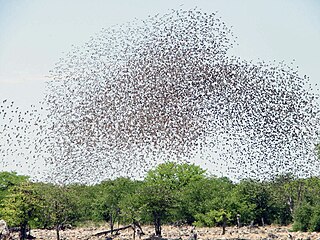
Quelea is a genus of small passerine birds that belongs to the weaver family Ploceidae, confined to Africa. These are small-sized, sparrow- or finch-like gregarious birds, with bills adapted to eating seeds. Queleas may be nomadic over vast ranges; the red-billed quelea is said to be the most numerous bird species in the world.
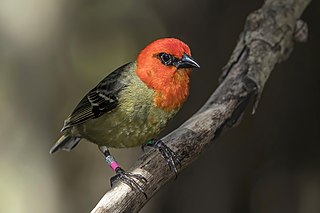
The Mauritius fody is a rare species of bird in the weaver family. It is endemic to the island of Mauritius. It is classified by BirdLife International as being endangered. It is also on the United States' Endangered Species List with an endangered status.

The Seychelles fody is a small yellowish songbird that are native to the Seychelles islands of Cousin Island, Cousine Island, Frégate Island, and have been introduced to Aride Island, D'Arros Island and as of 2004 Denis Island. Their natural habitat is woodland, but they have adapted to living in such habitats as coconut plantations and gardens.
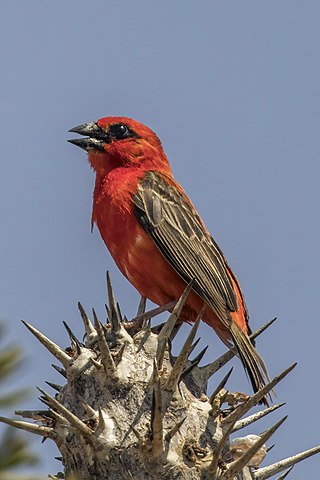
The red fody, also known as the Madagascar fody in Madagascar, red cardinal fody in Mauritius, or common fody, is a small bird native to Madagascar and introduced to various other islands in the Indian Ocean. It is a common bird within its restricted range, and the International Union for Conservation of Nature has assessed its conservation status as being of "least concern".

Anaplectes is a genus of African birds in the weaver family Ploceidae.
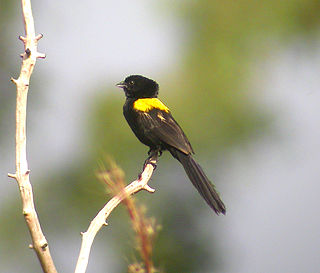
The yellow-mantled widowbird, also known as the yellow-backed widow, is a species of bird in the family Ploceidae.

The Comoros fody, also known as the red-headed fody, is a species of passerine bird in the family Ploceidae. It is found in the Comoros. The taxon aldabrana, was previously often considered a subspecies of the Comoros fody. Previously, the forest fody from Madagascar was considered a subspecies of the Comoros fody.

The Rodrigues fody is a rare species of bird in the weaver family. It is endemic to Rodrigues, an island of Mauritius. It is classified by BirdLife International as being vulnerable. It is also on the United States' Endangered Species List with an endangered status.

The nelicourvi weaver is a species of bird in the family Ploceidae. It is endemic to Madagascar. Together with its closest relative, the sakalava weaver, it is sometimes placed in a separate genus Nelicurvius. A slender, sparrow-like bird, it is 15 cm (5.9 in) long and weighing 20–28 g (0.71–0.99 oz). Breeding males have a black bill and head, brown eyes, yellow collar, grey belly, chestnut-brown lower tail coverts, olive back, and blackish flight feathers edged greenish. Non-breeding males have mottled grey and green heads. In the breeding female the front of the head is yellow and the back olive green, with a broad yellow eyebrow. It builds solitary, roofed, retort-shaped nests, hanging by a rope from a branch, vine or bamboo stem, in an open space. It primarily feeds on insects, looking on its own or in very small groups, often together with long-billed bernieria. Its natural habitat is subtropical or tropical moist lowland and mountain forests. The conservation status of Nelicourvi weaver is least concern according to the IUCN Red List.
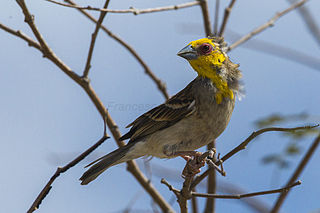
The Sakalava weaver sometimes known as the Sakalava fody is a species of bird in the family Ploceidae. It is endemic to Madagascar. The bird is 15 cm (5.9 in) long and weighs 20–28 g (0.71–0.99 oz).

The grey-capped social weaver is a sparrow-like liver-colored bird, with a pale grey crown, a dark grey bill, a whitish eye-ring, horn-colored legs, with some black in the wing and a light terminal band in the tail, that builds roofed nests made of straws, breeds in colonies in thorny Acacia trees, and feeds in groups gathering grass seeds and insects. Male and female have near identical plumage. DNA-analysis confirms it is part of the weaver family. It is found in Ethiopia, Kenya, Somalia, South Sudan, Sudan, Tanzania, and Uganda.

The cardinal quelea is a species of bird in the family Ploceidae. It is found in Burundi, Democratic Republic of the Congo, Ethiopia, Kenya, Malawi, Rwanda, South Sudan, Tanzania, Uganda, and Zambia.

The red-headed quelea is a species of bird in the family Ploceidae. It is found in Angola, Benin, Botswana, Burkina Faso, Burundi, Cameroon, Central African Republic, Chad, Republic of the Congo, Democratic Republic of the Congo, Ivory Coast, Equatorial Guinea, Eswatini, Ethiopia, Gabon, Gambia, Ghana, Guinea, Guinea-Bissau, Kenya, Liberia, Malawi, Mali, Mozambique, Niger, Nigeria, Rwanda, São Tomé and Príncipe, Senegal, Sierra Leone, South Africa, South Sudan, Tanzania, Togo, Uganda, Zambia, and Zimbabwe.

The southern red bishop or red bishop is a small passerine bird belonging to the bishop and widowbird genus Euplectes in the weaver family, the Ploceidae. It is common in wetlands and grassland in Africa south of the Equator. North of the Equator, it is replaced by the northern red bishop or orange bishop which was formerly regarded as a subspecies of this species.
The Réunion fody is an extinct bird species from the family of weavers. It was endemic to the Mascarene island of Réunion.

The yellow-crowned bishop is a species of passerine bird in the family Ploceidae native to Africa south of the Sahara. It is highly sexually dimorphic in its breeding season, during which the male adopts a distinctive yellow and black plumage, contrasting with the female's predominantly brown coloration. Four subspecies are recognised.

The Aldabra fody is a passerine bird in the family Ploceidae. It is endemic to Aldabra, an atoll northwest of Madagascar, part of Seychelles. Regarded as conspecific with the Comoros fody in the past, it is now recognized as a distinct species by the International Union for the Conservation of Nature (IUCN). Both sexes are yellow in color across much of the body, with breeding males orange-scarlet on the head and neck. The species has a large and powerful bill, used to compete with other birds of Aldabra for food. Nesting occurs over several months, often in introduced coconut palms and Casuarina trees. The Aldabra fody is considered endangered by the IUCN, threatened by predation of nests and drought. Hybridization with the related Madagascar fody has occurred in the past, but is not currently considered a danger to the species.





















